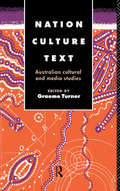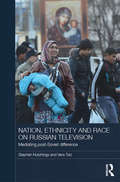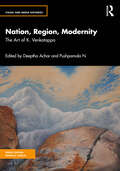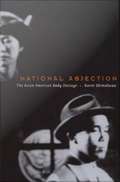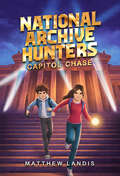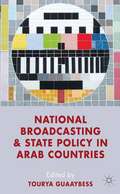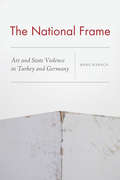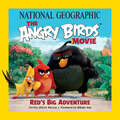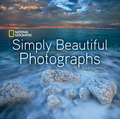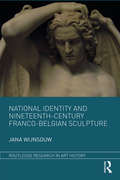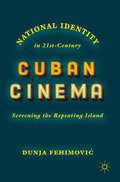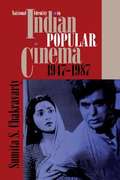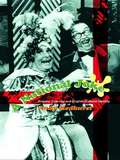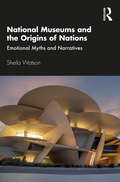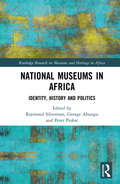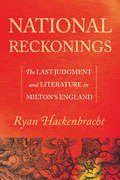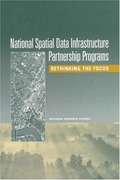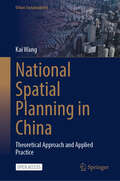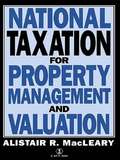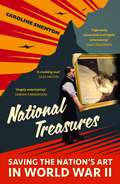- Table View
- List View
Nation, Culture, Text: Australian Cultural and Media Studies (Communication and Society)
by Graeme TurnerNation, Culture, Text: Australian Cultural and Media Studies is the first collection of cultural studies from Australia, selected and introduced for an international readership.Participating in the `de-centring' of cultural studies - considering what perspectives other than the European and the American have to offer - the contributors raise important issues about the role of a national tradition of critical theory, and about the cultural specificity of theory itself.A key theme is the place of the postcolonial nation within contemporary cultural theory - particularly those aspects of contemporary theory which see the category of contemporary theory which see the category of the nation as either outdated or suspect. The writers tackle subjects ranging from the televising of the Bicentennial to the role of policy in film, television and the heritage industry, from the use of video technologies with remote Aboriginal communities to the role of ethnography in cultural studies.
Nation, Ethnicity and Race on Russian Television: Mediating Post-Soviet Difference (BASEES/Routledge Series on Russian and East European Studies)
by Stephen Hutchings Vera TolzRussia, one of the most ethno-culturally diverse countries in the world, provides a rich case study on how globalisation and associated international trends are disrupting, and causing the radical rethinking of approaches to, inter-ethnic cohesion. The book highlights the importance of television broadcasting in shaping national discourse and the place of ethno-cultural diversity within it. It argues that television’s role here has been reinforced, rather than diminished, by the rise of new media technologies. Through an analysis of a wide range of news and other television programmes, the book shows how the covert meanings of discourse on a particular issue can diverge from the overt significance attributed to it, just as the impact of that discourse may not conform with the original aims of the broadcasters. The book discusses the tension between the imperative to maintain security through centralised government and overall national cohesion that Russia shares with other European states, and the need to remain sensitive to, and to accommodate, the needs and perspectives of ethnic minorities and labour migrants. It compares the increasingly isolationist popular ethnonationalism in Russia, which harks back to "old-fashioned" values, with the similar rise of the Tea Party in the United States and the UK Independence Party in Britain. Throughout, this extremely rich, well-argued book complicates and challenges received wisdom on Russia’s recent descent into authoritarianism. It points to a regime struggling to negotiate the dilemmas it faces, given its Soviet legacy of ethnic particularism, weak civil society, large native Muslim population and overbearing, yet far from entirely effective, state control of the media.
Nation, Region, Modernity: The Art of K. Venkatappa (Visual and Media Histories)
by Deeptha Achar Pushpamala N.This volume explores the Indian artist, K. Venkatappa’s life (1886–1965), his works and the political and cultural contexts that influenced and inspired his art. It looks at the artist’s style and examines the question of modernity in Indian art through the interstices of the regional and the national. This richly illustrated book contextualises Venkatappa’s work in the milieu of Calcutta, princely Mysore and later Bangalore in the first half of the twentieth century, at a time when boundaries, horizons, and identities were in great flux. It complicates a unitary history of modern Indian art and, indeed, modernity in colonial India with its engagement with the question of region. The volume discusses Venkatappa’s engagements with Indian artistic nationalism, the Bengal Renaissance, asceticism, as well as western modernist art and highlights the ambivalences and contradictions in his work. Through an in-depth reading of these diverse contexts, the essays in this book examine the artist’s legacy and his contemporary relevance, while showing how the trajectories of regional modernities can unsettle singular accounts of a nation’s art. This volume, part of the Visual Media and Histories Series, will be of interest to students and researchers of history of art, history, modern Indian art, visual studies, and cultural studies.
National Abjection: The Asian American Body Onstage
by Karen ShimakawaNational Abjection explores the vexed relationship between "Asian Americanness" and "Americanness" through a focus on drama and performance art. Karen Shimakawa argues that the forms of Asian Americanness that appear in U. S. culture are a function of national abjection--a process that demands that Americanness be defined by the exclusion of Asian Americans, who are either cast as symbolic foreigners incapable of integration or Americanization or distorted into an "honorary" whiteness. She examines how Asian Americans become culturally visible on and off stage, revealing the ways Asian American theater companies and artists respond to the cultural implications of this abjection. Shimakawa looks at the origins of Asian American theater, particularly through the memories of some of its pioneers. Her examination of the emergence of Asian American theater companies illuminates their strategies for countering the stereotypes of Asian Americans and the lack of visibility of Asian American performers within the theater world. She shows how some plays--Wakako Yamauchi's 12-1-A, Frank Chin's Chickencoop Chinaman, and The Year of the Dragon--have both directly and indirectly addressed the displacement of Asian Americans. She analyzes works attempting to negate the process of abjection--such as the 1988 Broadway production of M. Butterfly as well as Miss Saigon, a mainstream production that enacted the process of cultural displacement both onstage and off. Finally, Shimakawa considers Asian Americanness in the context of globalization by meditating on the work of Ping Chong, particularly his East-West Quartet.
National Archive Hunters 1: Capitol Chase
by Matthew LandisTwins race to find the thief stealing valuable historical artifacts before their family&’s framed for the crimes in this high-octane middle grade action-adventure series starter for fans of City Spies and Alex Rider.Ten-year-old Ike Carter has committed large chunks of American history to memory. That&’s what happens when you&’re a genius who loves the past. His twin, Iris, prefers the present (aka reality). She&’s an elite athlete, dominating the competition thanks to her wicked-sharp spatial awareness.During the opening night of a new exhibit at their mom&’s boutique museum in Washington, D.C., Ike and Iris inadvertently stumble onto a robbery in progress. A girl not much older than them is stealing a miniature portrait of George Washington from the collection. It's only the first in a string of crimes, all focused on items that were once gifted by the Marquis de Lafayette to his American friends. With some help from the National Archives Research Center, the twins puzzle out the culprit&’s next targets, and are soon hot on the trail of the mystery girl.But their efforts also put them in the crosshairs of the FBI&’s Art Crime team, who suspect their family is involved. If the twins can&’t catch the real perp as they target the final item, it&’ll be game over.An action-packed series opener from highly-acclaimed author Matthew Landis, Capitol Chase introduces a new secret agent team sure to engross fans of National Treasure, City Spies, and Alex Rider with plot twists and turns that make this one unputdownable from first page to last.A Junior Library Guild Gold Standard Selection
National Broadcasting and State Policy in Arab Countries
by Tourya GuaaybessA state-of-the-art analysis of the situation of national television in Arab countries, addressing what Arab national broadcastings today say about public policy and political opening. The essays deal with the reforms of public broadcasting organizations and the evolution, perspectives and issues of national broadcasting.
The National Frame: Art and State Violence in Turkey and Germany
by Banu KaracaBased on long-term ethnographic research in the art worlds of Istanbul and Berlin, The National Frame rethinks the politics of art by focusing on the role of art in state governance. It argues that artistic practices, arts patronage and sponsorship, collecting and curating art, and the modalities of censorship continue to be refracted through the conceptual lens of the nation-state, despite the globalization of the arts. By examining discussions of the civilizing function of art in Turkey and Germany and particularly moments in which art is seen to cede this function, The National Frame reveals the histories of violence on which the production, circulation, and, very understanding of art are predicated. Karaca examines this darker side of art in two cities in which art and its institutions have been intertwined with symbolic and material dispossession. The particularities of German and Turkish contexts, both marked by attempts to claim modern nationhood through the arts; illuminate how art is staked to memory and erasure, resistance and restoration; and why art has been at once vital and unwieldy for national projects. As art continues to be called upon to engage the past and imagine different futures, The National Frame explores how to reclaim art’s emancipatory potential.
National Geographic The Angry Birds Movie: Red's Big Adventure
by Christy Ullrich BarcusThis latest entry in the National Geographic Angry Birds series will take you on an amazing journey with Red, the leader of the Angry Birds flock, along with Matilda, Chuck, Bomb, Terence, and the mysterious Mighty Eagle. Featuring The Angry Birds Movie (2016) story world, this book is filled with all the fun facts and information Red and the flock need to embark on their big adventure. From identifying wildlife to navigating by the stars to building a shelter and setting traps (for any roaming Piggies), this book will be sure to educate and entertain.
National Geographic Photo Basics: The Ultimate Beginner's Guide to Great Photography
by Joel SartoreFor digital camera and smartphone users, this easy how-to guide, written by an experienced National Geographic photographer, imparts the essentials of taking great pictures. <p><p>This entertaining book from beloved National Geographic photographer and Photo Ark founder Joel Sartore shows aspiring photographers how to take great pictures, from framing and F-stops to editing and archiving. Whether you're using your phone or a DSLR camera, you'll learn the fundamentals of photography--and how to put them to work every day.
National Geographic Simply Beautiful Photographs
by Annie GriffithsNational Geographic Simply Beautiful Photographs takes readers on a spectacular visual journey through some of the most stunning photographs to be found in National Geographic's famed Image Collection. Award-winning photographer Annie Griffiths culled the images to reflect the many variations on the universal theme of beauty. Chapters are organized around the aesthetic concepts that create beauty in a photograph: Light, Composition, Moment (Gesture and Emotion), Motion, Palette, and Wonder.
National Geographic Simply Beautiful Photographs
by Annie GriffithsNational Geographic Simply Beautiful Photographs takes readers on a spectacular visual journey through some of the most stunning photographs to be found in National Geographic's famed Image Collection. Award-winning photographer Annie Griffiths culled the images to reflect the many variations on the universal theme of beauty. Chapters are organized around the aesthetic concepts that create beauty in a photograph: Light, Composition, Moment (Gesture and Emotion), Motion, Palette, and Wonder. Beyond the introduction and brief essays about each featured concept, the text is light. The photographs speak for themselves, enhanced by lyrical quotes from scholars and poets. In the chapter on Light, for example, we read these words of whimsical wisdom from songwriter Leonard Cohen: "Ring the bells that still can ring. Forget your perfect offering. There is a crack in everything. That's how the lights get in. " And then the images flow, of light entering scenes via windows, clouds, and spotlights, from above, alongside, and behind, casting radiance upon young ballerinas and weathered men, into groves of autumn trees and island-dotted seas, revealing everything it touches to be beautiful beyond expectation. To illuminate the theme of Wonder, Griffiths chose a wish from Andre Bazin: "If I had influence with the good fairy. . . I should ask that her gift to each child in the world be a sense of wonder so indestructible that it would last throughout life. " This thought is juxtaposed with an exquisite vision in white, a frame filled with the snowy-pure dots and rays of a bird's fan tail. And on it goes, picture after tantalizing picture, alive with wondrous beauty. When she created National Geographic Simply Beautiful Photographs, Annie Griffiths set two goals: to maximize visual delight, and to create a book unique in the world of publishing--one in which many of the photographs could be purchased as prints. She has succeeded on both counts. Many of these stunning images are available for order, and there can be no doubt as to the visual delight. You must open this book for yourself, and take in its radiant beauty.
National Geographic Simply Beautiful Photographs
by Annie GriffithsNational Geographic Simply Beautiful Photographs takes readers on a spectacular visual journey through some of the most stunning photographs to be found in National Geographic's famed Image Collection. Award-winning photographer Annie Griffiths culled the images to reflect the many variations on the universal theme of beauty. Chapters are organized around the aesthetic concepts that create beauty in a photograph: Light, Composition, Moment (Gesture and Emotion), Motion, Palette, and Wonder.Beyond the introduction and brief essays about each featured concept, the text is light. The photographs speak for themselves, enhanced by lyrical quotes from scholars and poets. In the chapter on Light, for example, we read these words of whimsical wisdom from songwriter Leonard Cohen: "Ring the bells that still can ring. Forget your perfect offering. There is a crack in everything. That's how the lights get in." And then the images flow, of light entering scenes via windows, clouds, and spotlights, from above, alongside, and behind, casting radiance upon young ballerinas and weathered men, into groves of autumn trees and island-dotted seas, revealing everything it touches to be beautiful beyond expectation.To illuminate the theme of Wonder, Griffiths chose a wish from Andre Bazin: "If I had influence with the good fairy...I should ask that her gift to each child in the world be a sense of wonder so indestructible that it would last throughout life." This thought is juxtaposed with an exquisite vision in white, a frame filled with the snowy-pure dots and rays of a bird's fan tail. And on it goes, picture after tantalizing picture, alive with wondrous beauty.When she created National Geographic Simply Beautiful Photographs, Annie Griffiths set two goals: to maximize visual delight, and to create a book unique in the world of publishing--one in which many of the photographs could be purchased as prints. She has succeeded on both counts. Many of these stunning images are available for order, and there can be no doubt as to the visual delight. You must open this book for yourself, and take in its radiant beauty.
National Identity and Nineteenth-Century Franco-Belgian Sculpture (Routledge Research in Art History)
by Jana WijnsouwThis book elaborates on the social and cultural phenomenon of national schools during the nineteenth century, via the less studied field of sculpture and using Belgium as a case study. The role, importance of, and emphasis on certain aspects of national identity evolved throughout the century, while a diverse array of criteria were indicated by commissioners, art critics, or artists that supposedly constituted a "national sculpture." By confronting the role and impact of the four most crucial actors within the artistic field (politics, education, exhibitions, public commissions) with a linear timeframe, this book offers a chronological as well as a thematic approach. Artists covered include Guillaume Geefs, Eugène Simonis, Charles Van der Stappen, Julien Dillens, Paul Devigne, Constantin Meunier, and George Minne.
National Identity in 21st-Century Cuban Cinema: Screening the Repeating Island
by Dunja FehimovićNational Identity in 21st-Century Cuban Cinema tours early 21st-century Cuban cinema through four key figures—the monster, the child, the historic icon, and the recluse—in order to offer a new perspective on the relationship between the Revolution, culture, and national identity in contemporary Cuba. Exploring films chosen to convey a recent diversification of subject matters, genres, and approaches, it depicts a changing industrial landscape in which the national film institute (ICAIC) coexists with international co-producers and small, ‘independent’ production companies. By tracing the reappearance, reconfiguration, and recycling of national identity in recent fiction feature films, the book demonstrates that the spectre of the national haunts Cuban cinema in ways that reflect intensified transnational flows of people, capital, and culture. Moreover, it shows that the creative manifestations of this spectre screen—both hiding and revealing—a persistent anxiety around Cubanness even as national identity is transformed by connections to the outside world.
National Identity in Indian Popular Cinema, 1947-1987
by Sumita S. ChakravartyAlthough Indian popular cinema has a long history and is familiar to audiences around the world, it has rarely been systematically studied. This book offers the first detailed account of the popular film as it has grown and changed during the tumultuous decades of Indian nationhood. The study focuses on the cinema's characteristic forms, its range of meanings and pleasures, and, above all, its ideological construction of Indian national identity.<P><P>Informed by theoretical developments in film theory, cultural studies, postcolonial discourse, and "Third World" cinema, the book identifies the major genres and movements within Bombay cinema since Independence and uses them to enter larger cultural debates about questions of identity, authenticity, citizenship, and collectivity. Chakravarty examines numerous films of the period, including Guide (Vijay Anand, 1965), Shri 420 [The gentleman cheat] (Raj Kapoor, 1955), and Bhumika [The role] (Shyam Benegal, 1977). She shows how "imperso-nation," played out in masquerade and disguise, has characterized the representation of national identity in popular films, so that concerns and conflicts over class, communal, and regional differences are obsessively evoked, explored, and neutralized.
A National Joke: Popular Comedy and English Cultural Identities
by Andy MedhurstComedy is crucial to how the English see themselves. This book considers that proposition through a series of case studies of popular English comedies and comedians in the twentieth century, ranging from the Carry On films to the work of Mike Leigh and contemporary sitcoms such as The Royle Family, and from George Formby to Alan Bennett and Roy 'Chubby' Brown. Relating comic traditions to questions of class, gender, sexuality and geography, A National Joke looks at how comedy is a cultural thermometer, taking the temperature of its times. It asks why vulgarity has always delighted English audiences, why camp is such a strong thread in English humour, why class influences what we laugh at and why comedy has been so neglected in most theoretical writing about cultural identity. Part history and part polemic, it argues that the English urgently need to reflect on who they are, who they have been and who they might become, and insists that comedy offers a particularly illuminating location for undertaking those reflections.
National Museum of Dance and Hall of Fame: Celebrating 30 Years (Excelsior Editions)
by Lisa Schlansker KolosekThe only museum in the United States dedicated entirely to the art form of dance, the National Museum of Dance and Hall of Fame opened in June 1987, after a short preview season the summer before. This unique and special place celebrates its thirtieth anniversary in 2017. To commemorate this milestone, Lisa Schlansker Kolosek has created a rich pictorial history tracing not only the museum's remarkable evolution but the relevance of the museum to the city of Saratoga Springs, New York.Kolosek tells the story of the museum's origins, from its notable founders' grand idea to the selection and complete renovation of a historic 1920s bath house as its home. Combining a complete survey of exhibitions presented by the museum and the incredible history of the Hall of Fame, which recognizes dance luminaries across multiple genres, this book offers an in-depth look at the museum's expansive collection of costumes, visual art, and archival materials. The book also covers the history of the museum's Lewis A. Swyer Studios and School of the Arts, a leader in dance education. Beautifully illustrated with more than four hundred photographs, this book pays tribute to the immense impact of the National Museum of Dance and Hall of Fame.
National Museums and the Origins of Nations: Emotional Myths and Narratives
by Sheila WatsonNational Museums and the Origins of Nations provides the first international survey of origins stories in national museums and examines the ways in which such museums use the distant past as a vehicle to reflect the concerns of the political present. Offering an international comparison of institutions in China, North and South America, the Middle East, Europe and Australia, the book argues that national museums tell us more about what sort of community a nation wishes to be today, than how and why that nation came into being. Watson also reveals the ways in which narrative and exhibition design attempt to engage the visitor in an emotional experience designed to promote loyalty to, and pride in, the nation, or to remind visitors who are not citizens that they do not belong. These narratives of origin are, it is claimed, based on so-called factual accuracies, but this book reveals that they are often selective, emotional and rarely critiqued within institutions. At a time when nationalism is very much back on the political agenda, this book highlights how museums reflect current political and social concerns. National Museums and the Origins of Nations will appeal to academics and students engaged in the study of museums, heritage, politics, nationalism and history.
National Museums in Africa: Identity, History and Politics (Routledge Research on Museums and Heritage in Africa)
by Raymond Silverman George Abungu Peter ProbstNational Museums in Africa brings the voices of African museum professionals into dialogue with scholars and, by so doing, is able to consider the state of African national museums from fresh perspectives. Covering all regions of the continent, the volume’s thirteen chapters allow for a deep and nuanced understanding of the intricate interplay between past and present in contemporary Africa. Taking stock of the shifting museum landscape in Africa, with new players like China and South Korea challenging the conditions of cultural exchange, the book demonstrates that national museums are being rediscovered as important sites of political engagement and cultural negotiation. This is the first book to critically examine the roles national museums in Africa have played in the societies in which they are situated, but it is also the first to consider the roles that national museums might play in current debates concerning the restitution and repatriation of cultural patrimony taken from Africa during the colonial era. Informed by a comparative and interdisciplinary perspective, this ground-breaking book will appeal to anyone interested in museums in Africa. It will be particularly useful to scholars and students working in the areas of museum and heritage studies, African studies, anthropology, archaeology, history, art history and cultural studies.
National Performance
by Erin HurleyIn National Performance, Erin Hurley examines the complex relationship between performance and national identity. How do theatrical performances represent the nation in which they were created? How is Quebecois performance used to define Quebec as a nation and to cultivate a sense of 'Quebec-ness' for audiences both within and outside the province? In exploring Expo 67, the critical response to Michel Tremblay's Les Belles Soeurs, Carbone 14's image-theatre, Marco Micone's writing practices, Celine Dion's popular music, and feminist performance of the 1970s and 80s, Hurley reveals the ways in which certain performances come to be understood as 'national' while others are relegated to sub-national or outsider status. Each chapter focuses on a particular historical moment in Quebec's modern history and a genre of performance emblematic of the moment, and uses these to elaborate the nature of the national performances.Winner of the Northeast Modern Language Association's Book Prize, National Performance is sophisticated yet accessible, seeking to enlarge the parameters of what counts as 'Quebecois' performance, while providing a thorough introduction to changing discourses of nation-ness in Quebec.
National Reckonings: The Last Judgment and Literature in Milton’s England
by Ryan HackenbrachtDuring the tumultuous years of the English Revolution and Restoration, national crises like civil wars and the execution of the king convinced Englishmen that the end of the world was not only inevitable but imminent. National Reckonings shows how this widespread eschatological expectation shaped nationalist thinking in the seventeenth century. Imagining what Christ's return would mean for England's body politic, a wide range of poets, philosophers, and other writers—including Milton, Hobbes, Winstanley, and Thomas and Henry Vaughan,—used anticipation of the Last Judgment to both disrupt existing ideas of the nation and generate new ones. Ryan Hackenbracht contends that nationalism, consequently, was not merely a horizontal relationship between citizens and their sovereign but a vertical one that pitted the nation against the shortly expected kingdom of God. The Last Judgment was the site at which these two imagined communities, England and ecclesia (the universal church), would collide. Harnessing the imaginative space afforded by literature, writers measured the shortcomings of an imperfect and finite nation against the divine standard of a perfect and universal community. In writing the nation into end-times prophecies, such works as Paradise Lost and Leviathan offered contemporary readers an opportunity to participate in the cosmic drama of the world's end and experience reckoning while there was still time to alter its outcome.
National Spatial Data Infrastructure Partnership Programs: Rethinking the Focus
by National Research CouncilThe National Academies Press (NAP)--publisher for the National Academies--publishes more than 200 books a year offering the most authoritative views, definitive information, and groundbreaking recommendations on a wide range of topics in science, engineering, and health. Our books are unique in that they are authored by the nation's leading experts in every scientific field.
National Spatial Planning in China: Theoretical Approach and Applied Practice (Urban Sustainability)
by Kai WangThis open access book conducts systematic and comprehensive research on urban spatial development problems in China from territorial perspectives, based on the scientific theory on human settlements environment. By integrating the theories of globalization, spatial planning, state intervention, and beyond, the author systematically sorts out both domestic and foreign urban spatial planning theories at national levels. Moreover, population, industries, natural resources, ecological environments, and management mechanisms involved during the urbanization and urban development process were analyzed in order to propose the theory and methods of national spatial planning. This book is recommended for researchers and practitioners in the fields of human settlement environment, urban, and regional planning; graduate students as well as teachers of urban planning, geography, architecture, regional science, and other related majors in universities, and public officials.
National Taxation for Property Management and Valuation
by A Macleary A. MaclearyA clear and up-to-date guide to the UK tax system for surveyors and valuers which demonstrates land valuation for taxation purposes.
National Treasures: Saving The Nation's Art in World War II
by Caroline Shenton'Geeks triumph over the forces of darkness: nothing could have given me greater pleasure. Combining an exciting story with scrupulous research, Caroline Shenton has done her unlikely heroes proud' - Lucy WorsleyAs Hitler prepared to invade Poland during the sweltering summer of 1939, men and women from across London's museums, galleries and archives formulated ingenious plans to send the nation's highest prized objects to safety. Using stately homes, tube tunnels, slate mines, castles, prisons, stone quarries and even their own homes, a dedicated bunch of unlikely misfits packed up the nation's greatest treasures and, in a race against time, dispatched them throughout the country on a series of top-secret wartime adventures. National Treasures highlights a moment from our history when an unlikely coalition of mild-mannered civil servants, social oddballs and metropolitan aesthetes became the front line in the heritage war against Hitler. Caroline Shenton shares the interwoven lives of ordinary people who kept calm and carried on in the most extraordinary of circumstances in their efforts to save the Nation's historic identity.
